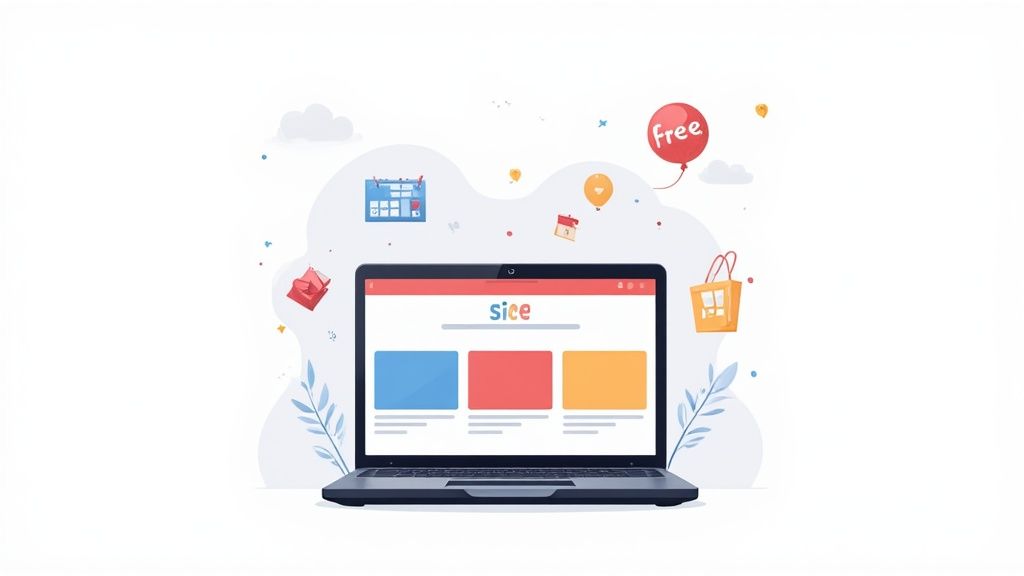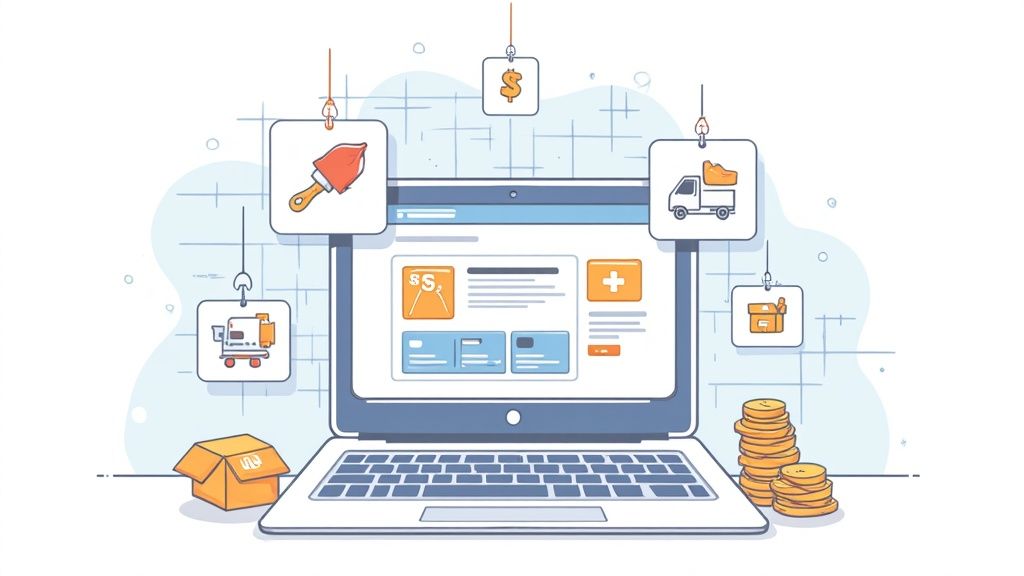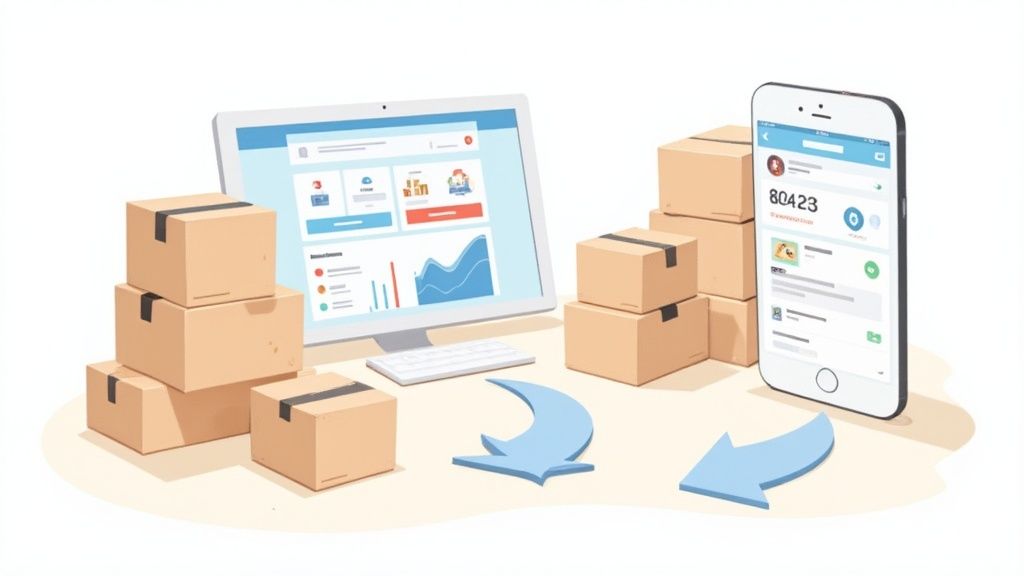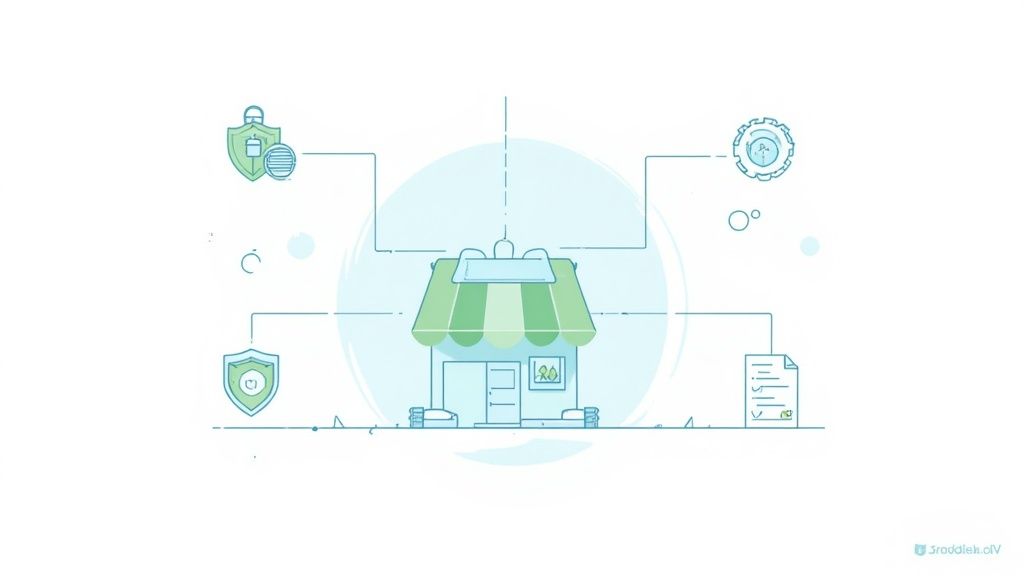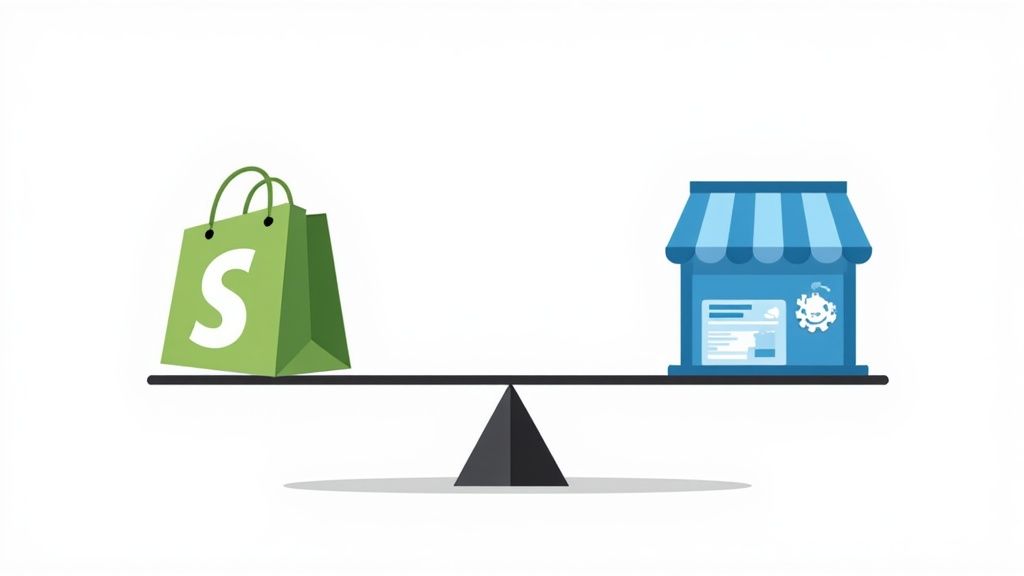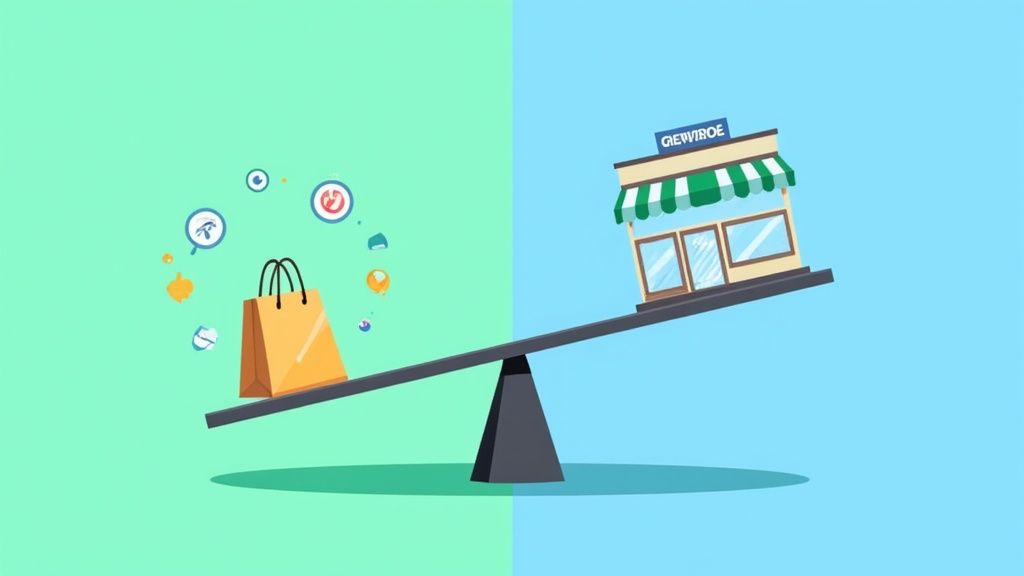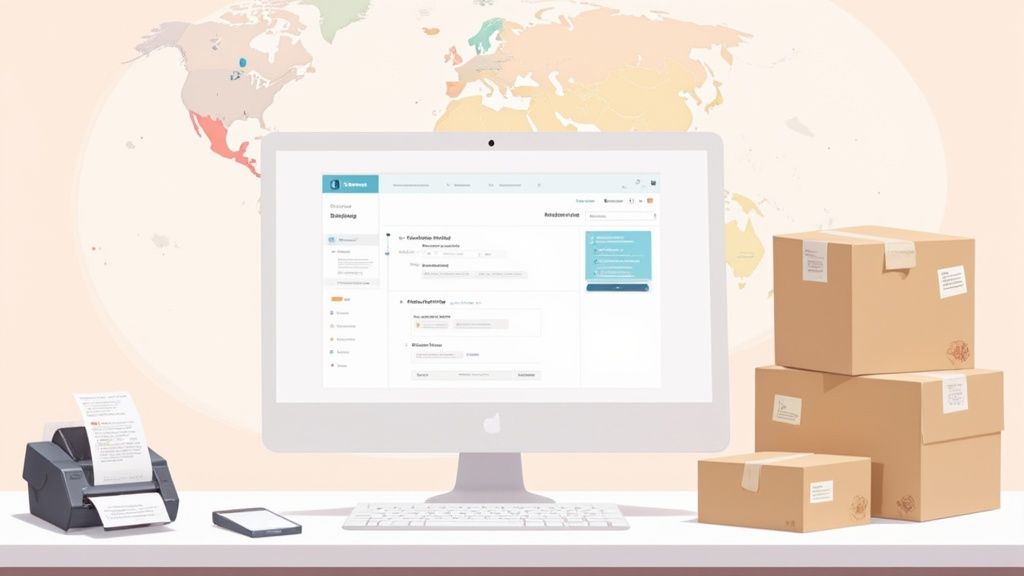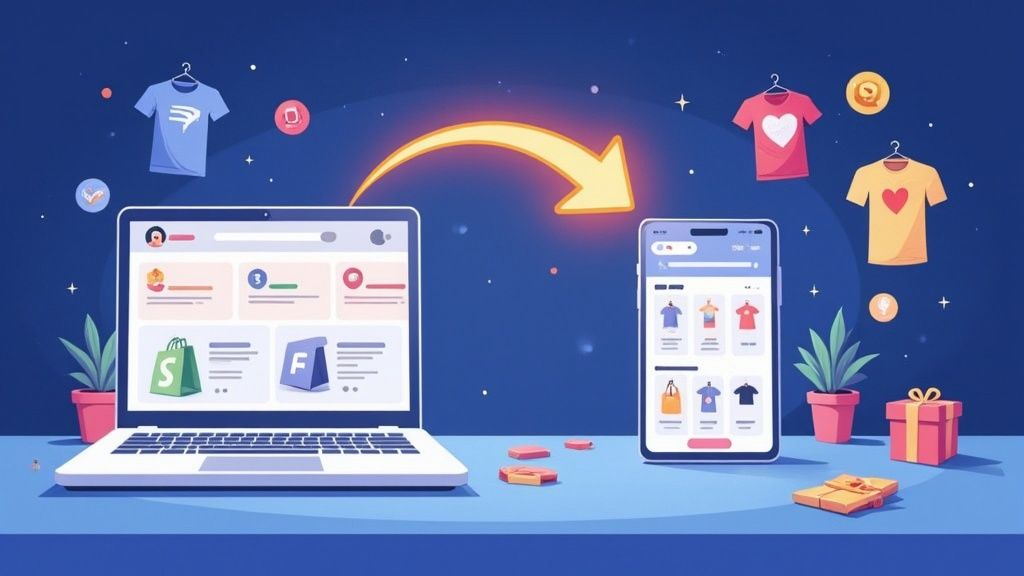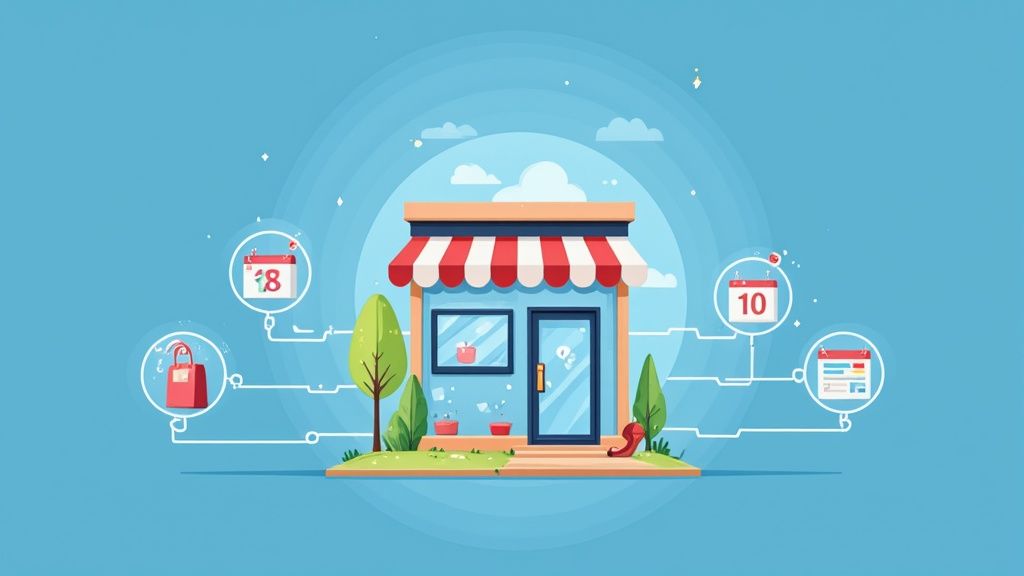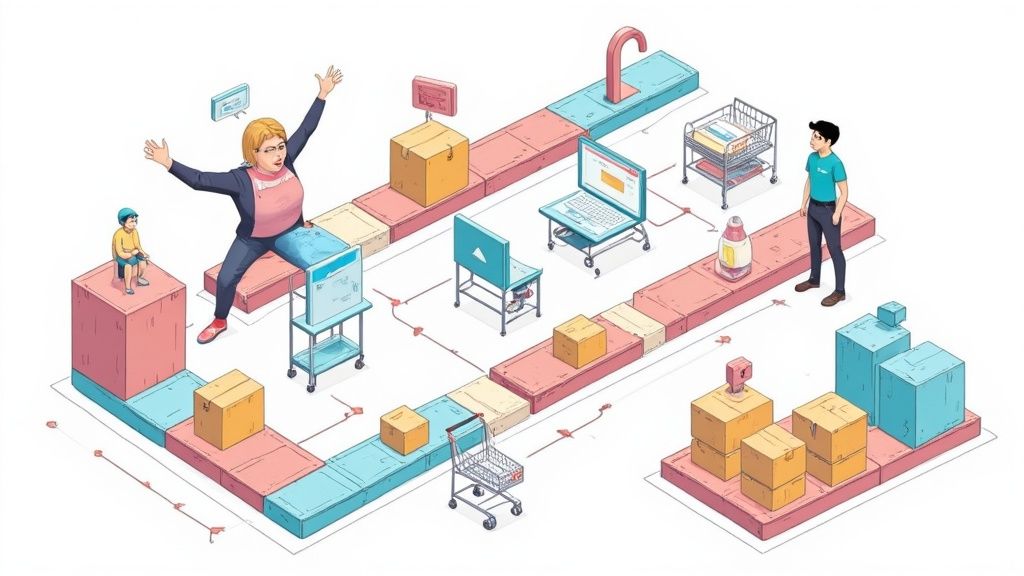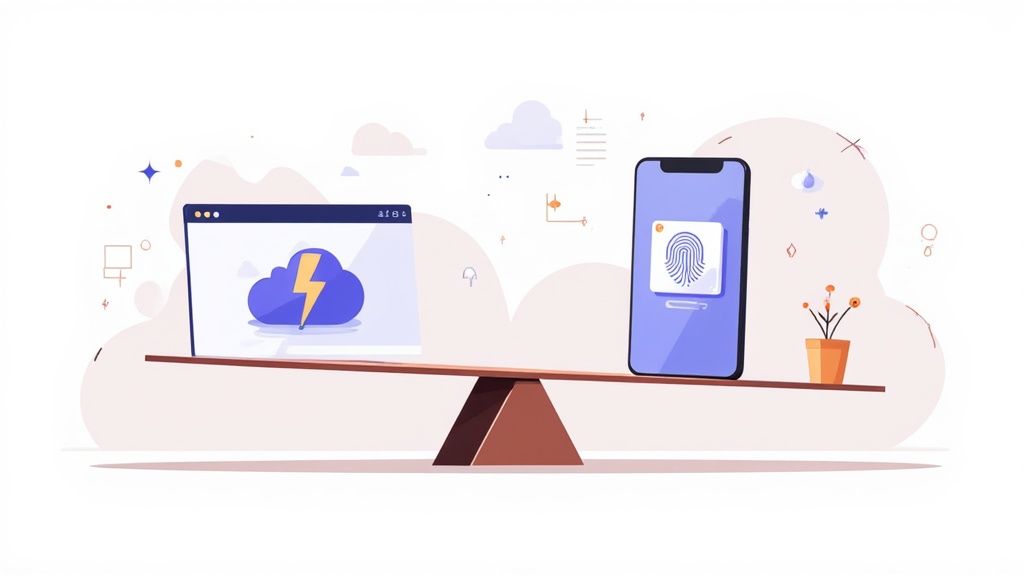
The easiest way to get customer reviews up and running on your Shopify store is by grabbing a dedicated app from the Shopify App Store. Sure, you could custom-code a solution if you're a developer, but for most of us, an app is the way to go.
Tools like Loox, Judge.me, or Yotpo offer reliable, feature-packed solutions that plug right into your store. They handle everything from asking customers for feedback to making those reviews look great on your product pages.
Why Customer Reviews Are Your Greatest Sales Asset
Before we get into the how, let's nail down the why. Customer reviews are so much more than a star rating and a few comments. They're the digital version of word-of-mouth marketing and a massive dose of social proof.
Think about it from your customer's shoes. They land on a product page, and they're looking for one thing: reassurance. They need to know if that t-shirt really fits true to size, if that gadget actually works as promised, or if that skincare product delivers real results. Your beautifully written product descriptions are great, but it's the feedback from real people that gives them the confidence to hit "add to cart."
Building Trust Through Transparency
Showing off your reviews—even the ones that aren't a perfect five stars—proves you're a transparent and confident brand. It tells your audience that you value their feedback and have nothing to hide. That kind of honesty is how you build a real, long-term relationship with your customers.
In my experience working with e-commerce brands, I’ve seen a direct line connecting authentic reviews to tangible business growth. This isn’t just a hunch; the numbers speak for themselves.
Studies show that a staggering 92% of consumers read online reviews before buying. Just having star ratings can boost conversion rates by up to 270%. On top of that, Shopify merchants who use reviews well have seen customer retention jump by as much as 50%. You can check out more Shopify statistics to see the full picture.
More Than Just Sales
Beyond just pushing that immediate sale, reviews do a few other critical jobs for your business:
- Customer Education: Reviews often answer practical questions you might not have thought to include in your product details. This can seriously cut down on the number of support tickets you have to answer.
- Product Improvement: All that feedback, good and bad, is basically free market research. It shows you exactly what customers love and where you have room to improve.
- Enhanced SEO: This user-generated content constantly adds fresh, relevant keywords to your product pages. Over time, this can give your search engine rankings a nice little boost.
At the end of the day, adding a review system isn't just about ticking a box. It's about building a core engine for trust, sales, and sustainable growth.
Choosing the Right Shopify Review App
Jumping into the Shopify App Store for a review app feels a bit like walking into a massive, overwhelming library. With over 500 options staring back at you, it's easy to just grab the most popular one and call it a day. But that's a mistake. The best app isn't the one with the most downloads; it's the one that fits your brand, your budget, and your specific goals like a glove.
Before you even start looking, ask yourself a few honest questions. Are photo and video reviews critical for showing off your product? How important is automating review request emails right now? And can the app’s review widget be tweaked to look like it was born on your site, not just slapped on?
Your goal is to find that sweet spot—a tool that’s powerful enough for your ambitions but not so loaded with features (and a hefty price tag) that you’re paying for things you won't use for another year.
Free vs. Premium Review Apps
A lot of store owners start with Shopify's old, free "Product Reviews" app. The catch? Shopify isn't developing it anymore, which leaves a gap for a truly reliable, no-cost solution. The good news is that most modern apps run on a "freemium" model, giving you a solid starting point without opening your wallet.
This graphic gives you a quick snapshot of the app landscape. It shows that plenty of apps offer a free starting point, and they're highly rated by other merchants.
As you can see, there's no shortage of well-loved options. In fact, more than half of them have a free plan, so you can start collecting reviews without any upfront investment.
On the other side of the coin, you have premium powerhouses like Loox, Yotpo, and Judge.me. These paid apps are packed with features designed to put your review collection on autopilot and turn that social proof into sales.
Here’s what you typically get with a premium plan:
- Automated Review Requests: Automatically send emails or even SMS messages after a customer makes a purchase.
- Photo & Video Reviews: Let customers show off their purchases, adding a layer of authenticity you can't fake.
- Rich Snippets: Get those star ratings to show up directly in Google search results, which is huge for click-through rates.
- Deep Customization: Fine-tune every pixel of the review widgets to perfectly match your brand’s identity.
Comparing Top Shopify Review Apps
To help you sift through the noise, I've put together a quick comparison of some of the most popular and effective review apps I've seen in the wild. This table breaks down their key features, what you can expect to pay, and who I think they're best suited for.
Every app has its strengths, so the "best" one really depends on your immediate needs and long-term vision. Don't get distracted by shiny features; focus on what will make a tangible impact on your store today.
How to Make the Right Choice
So, how do you decide? Think about your store's stage of growth. If you’re just starting out, a powerful free plan from an app like Judge.me is a fantastic way to build that initial social proof. As your sales grow, you can reinvest in a premium plan to unlock more powerful automation and marketing tools.
The best app is the one you'll actually use. Don't pay for a dozen features you won't touch for another year. Start with what you need now, and remember you can always upgrade later as your business scales.
Once you’ve picked an app, the work isn’t over. You’ll want to test different layouts and placements to see what converts best. When you get to that point, our guide on Shopify A/B testing can give you a framework for making smart, data-backed decisions. Choosing the app is step one; optimizing how you use it is what truly drives results.
Alright, let's get into the nitty-gritty of getting a review system up and running on your store. We’re moving past the why and into the how—from picking the right tool in the Shopify App Store to tweaking the settings that will turn it into a real sales driver.
First things first, you need to choose your weapon. Head over to the Shopify App Store and a quick search for "reviews" will pull up a whole host of excellent, highly-rated options.
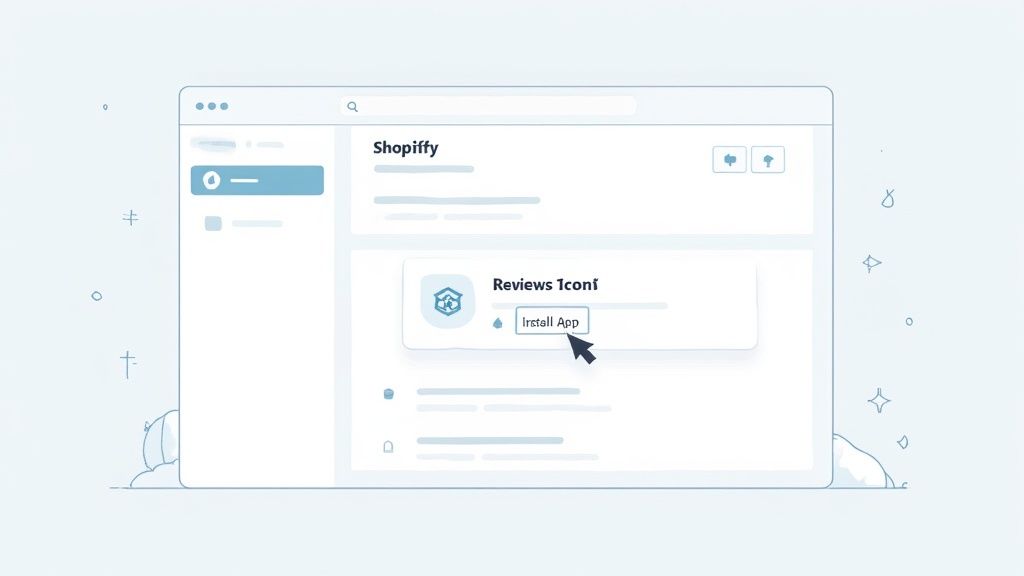
Once you've found an app that looks like a good fit, click "Add app." Shopify makes the installation process a breeze, connecting it directly to your store's backend with just a couple of clicks. That’s the easy part.
Customizing Your Review Widget
Now for the crucial bit. Once the app is installed, your first mission is to make the review widget look like it belongs on your site, not like a clunky, third-party plugin. A disjointed design can kill trust just as fast as having no reviews at all.
You'll usually find the customization panel in the "Apps" section of your Shopify admin. This is where the magic happens. A solid review app will give you plenty of control over the look and feel.
You should be able to tweak things like:
- Colors & Fonts: Match the widget to your brand’s color scheme and font choices. It should blend in seamlessly with your existing theme.
- Layout & Style: Do you want a simple list? A stylish grid? Maybe a carousel to showcase your best feedback? You can also decide where star ratings appear—on product pages, collection pages, or both.
- Widget Placement: Pinpoint exactly where on the product page you want reviews to show up. From experience, placing them right under the product description is usually the sweet spot for visibility.
This isn't just about making things look pretty; it's about building a smooth, credible user experience. A well-integrated widget feels professional and encourages shoppers to actually read what others are saying.
Pro Tip: Keep a product page open in another browser tab while you're customizing. You can refresh it to see your changes live, which makes fine-tuning the design so much faster than toggling back and forth.
Setting Up Automated Review Requests
Having a place for reviews is one thing, but you can't just sit back and hope people leave them. You have to ask. This is where automated post-purchase emails become your most powerful tool for collecting feedback while customer excitement is still high.
Dive back into your review app's dashboard and find a section for "Collect Reviews" or "Email Settings." The single most important setting here is the timing. You need to send that email after the customer has received and had a chance to try out their purchase.
Think about your shipping times. If an order typically takes 5-7 days to arrive, setting your automated email to go out 14 days after the purchase is a great starting point. This gives the customer plenty of time to experience the product but not so long that they've forgotten about it.
Most apps let you get even more granular, triggering the email based on order fulfillment or even delivery confirmation. Nailing the timing and the wording of that email is what separates a trickle of reviews from a flood of valuable social proof.
Getting Customers to Actually Leave Reviews
So you’ve installed a review app. That’s the easy part. The real challenge? Getting your customers to actually stop what they’re doing and write one. Simply flipping on a generic, automated email and hoping for a flood of five-star testimonials just isn't going to cut it. I've learned that the secret is to make your request personal, timely, and incredibly simple to act on.
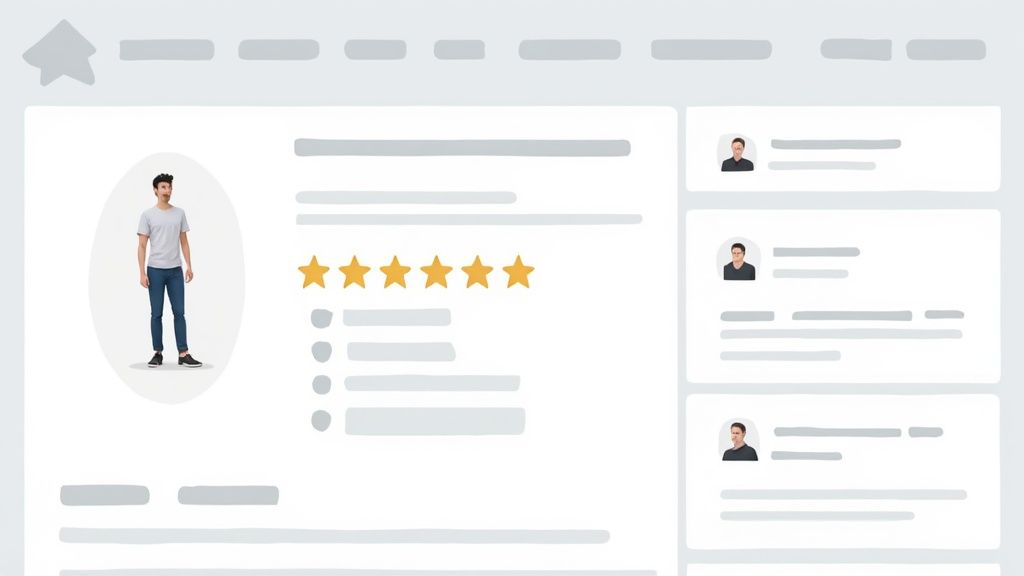
It’s time to move beyond the default "Please leave a review" message. Think about it from the customer's perspective. Instead of a bland, generic ask, craft a post-purchase email that feels like it was written just for them. Mention the specific product they bought and ask a targeted question. For example, "How is the fit of your new merino wool sweater?" feels far more human and is much more likely to prompt a detailed, thoughtful response.
Another powerful tactic I always recommend is offering a small incentive. This doesn't mean you have to break the bank. Even a 10% or 15% discount code for their next purchase can do wonders for your response rate. It's a simple gesture that shows you value their time and, as a bonus, encourages them to come back and shop again.
Making It Effortless for Customers
The single biggest enemy of customer reviews is friction. If someone has to click through multiple pages, create an account, or fill out a long, complicated form, they're gone. They’ll just abandon the process. Your number one goal should be to make leaving a review as easy as replying to a text message.
Here are a few practical ways to slash that friction:
- Use In-Email Forms: Some of the best review apps let customers write and submit their review directly within the email itself. This is a game-changer because you're not forcing them to click away and visit another page, which is where most people drop off.
- Keep It Minimal: Only ask for what's absolutely essential. A star rating and a comment box are usually all you need. Every extra field, like "Location" or "Age," is another reason for them to give up.
- Think Mobile-First: Most of your customers will open your email on their phone. Make sure your review submission form looks and works perfectly on a small screen. If it’s a clunky experience, you’ve lost them.
The key is to time your request perfectly. You want to send it when their excitement is at its absolute peak—not so soon that the package hasn't even arrived, but not so late that the initial thrill has worn off. For most products, that sweet spot is somewhere between 7-14 days after delivery.
When you combine a personalized approach with a frictionless submission process and a well-timed ask, you’re doing more than just begging for a review. You’re creating an experience that makes customers want to share their feedback. This is how you build the authentic social proof that truly drives new sales.
Turning Your Reviews Into a Marketing Engine
Once you've got reviews flowing in, the real work begins. Collecting feedback is just the start; turning it into a powerful marketing asset is how you truly squeeze every drop of value out of it. It’s time to think beyond just having star ratings on your product pages. Let's talk about transforming this user-generated content into undeniable social proof that fuels your entire marketing strategy.
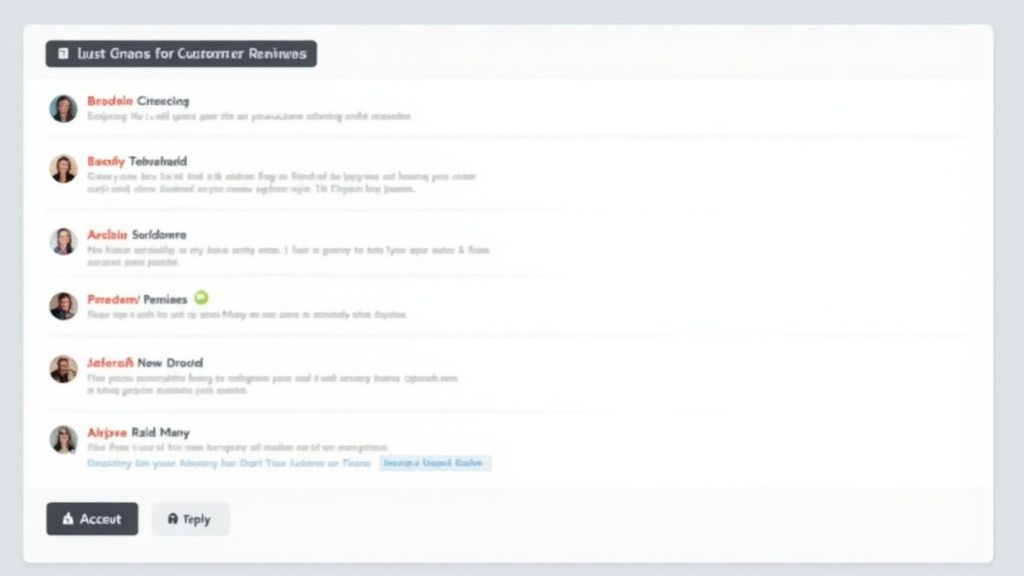
Your best reviews are pure marketing gold. Don't let them sit buried on a single product page. You need to strategically showcase your most glowing testimonials where they can have the biggest impact. This means getting them on your homepage, into your email newsletters, and even using them as creative for your social media ad campaigns.
Amplify Your Social Proof Everywhere
A single five-star review with a compelling story can be far more persuasive than any ad copy you could ever write yourself.
Here are a few places I've seen this work wonders:
- Homepage Hero Section: Feature a rotating carousel of your best, most impactful reviews.
- Email Campaigns: Drop a customer quote directly into your promotional emails to instantly build credibility.
- Social Media Ads: Turn a powerful review into a clean, simple graphic for a Facebook or Instagram ad. It feels authentic because it is.
This constant stream of fresh, user-generated content also has a significant, and often overlooked, SEO benefit. Search engines love pages with new, relevant content, and customer reviews provide exactly that. Every single review adds more long-tail keywords and natural language that real people are using to search for products just like yours.
The global e-commerce world is incredibly competitive. With Shopify holding 10.32% of the market share and being the platform of choice for 30% of U.S. merchants, standing out is non-negotiable. During high-traffic periods like Black Friday, strong customer reviews are what build the confidence needed to turn a browser into a buyer.
By putting your reviews to work across all your channels, they become a full-funnel asset. They help attract new customers with better SEO, convert them on-site with powerful social proof, and ultimately help you increase your Shopify sales with these proven strategies.
Common Questions About Adding Shopify Reviews
When you're diving into the world of customer reviews on Shopify, a few questions almost always surface. I've heard these from countless store owners over the years, so let's get them answered right away so you can move forward with confidence.
Can I Add Reviews to Shopify Without an App?
Technically, yes, a developer could build a custom review system from scratch. But honestly, for almost every store owner out there, this is a road you don't want to go down. It's incredibly complex, time-consuming, and expensive.
The much smarter—and standard—approach is to use a dedicated review app. Think of tools like Judge.me, Loox, or Yotpo. These are built specifically for Shopify, get regular updates, and give you a powerful, feature-rich system straight out of the box. It’s the practical choice.
Should I Publish Negative Reviews?
Absolutely, and I can't stress this enough. It might feel wrong to display criticism, but it's one of the best things you can do to build trust. Shoppers are smart; a page with nothing but five-star raves often feels fake or heavily censored.
Transparency is one of your most powerful assets. A study found that over 99% of online shoppers consult reviews. Seeing a mix of feedback, including thoughtful responses to criticism, proves you're an authentic and attentive brand. This can be more persuasive than a perfect score.
When you respond professionally and helpfully to a negative review, you're not just solving one customer's problem. You're showing every future visitor that you care and that you stand behind your products. It turns a potential negative into a public display of great customer service.
How Do I Import My Existing Reviews?
Great news—you don't have to start from zero. If you're moving over from another platform like Etsy or Amazon, you can bring all that hard-earned social proof with you.
Most of the top-tier review apps have built-in import features designed for this exact scenario. The process usually involves exporting your reviews from your old platform into a CSV file. You then simply upload that file into your new Shopify review app, and voilà—your past reviews are now live on your new store.
Will Adding a Review App Slow Down My Store?
This is a totally valid concern. Site speed is crucial, and adding any new app warrants a bit of caution.
However, reputable review app developers know this and design their software to be as lightweight as possible. Look for apps that mention performance optimization features like "lazy loading." This smart little trick makes sure the review widgets only load when a user scrolls down to them, so they don't impact your initial, all-important page load time. A well-coded app will have a minimal, often unnoticeable, effect on your store's speed.
Ready to elevate your store beyond just reviews? At ECORN, we specialize in comprehensive Shopify solutions, from conversion rate optimization to expert development. Let us help you turn your store into a high-performance sales machine. Explore our services and start your project today.






